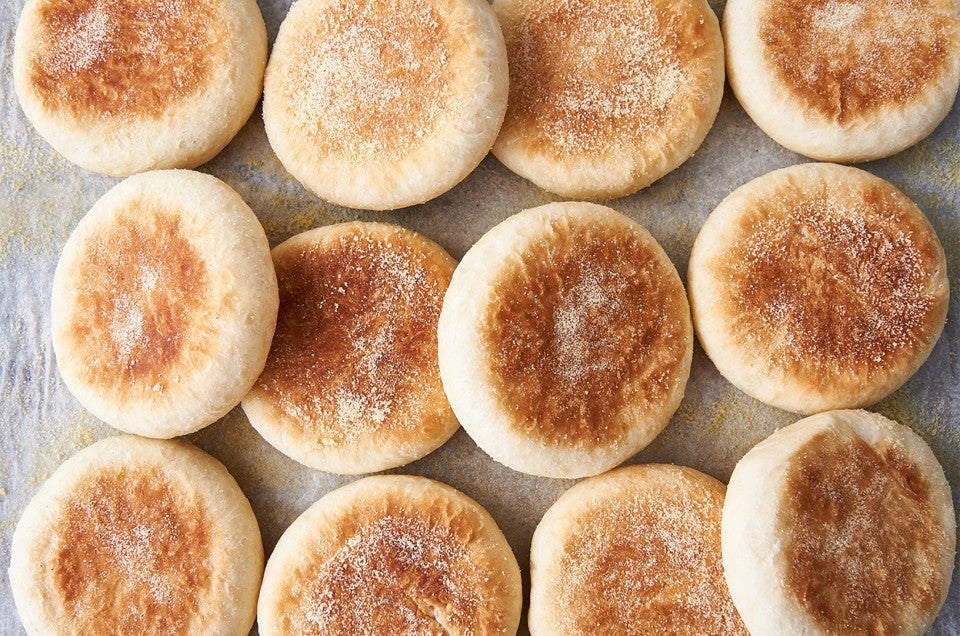


Ah, toasted English muffins.
Tender-crisp, brushed with melting butter, burned around the edges...
BURNED around the edges, you say?
Well, yeah. Have you ever managed to toast an English muffin without burning at least part of it?
I haven't. And my apparent lack of English muffin toasting skills led to a serious discussion here at King Arthur about the photogenicity (is that a word?) of charred-edge English muffins.
I think an English muffin with a bit of a burn looks fine; in fact, authentic, given the way they regularly come out of my toaster at home.
Some of my Web teammates think they look just fine... and some don't.
"But... it's burned!” cried one of the Webbies, as we went over photos for upcoming emails.
"Yeah, and?" I countered. "Aren't English muffins always just a little bit burned?”
“But, it looks bad. We can't use that shot. Don't you have something better?”
I appealed to my teammates for support.
“Hey, don't you guys burn your English muffins? Don't you think this is a good, real-life picture?”
Lukewarm assent from some. No response from others.
I guess the burning subject of burned English muffins just doesn't carry the fascination for others that it does for me.
I ended up losing this particular battle. I suggested switching the email picture to this:

Unburned English muffins. In fact, untoasted English muffins.
And I have to admit, they look quite handsome.

But ultimately, this was the winning email shot. And if this is what it takes to share a shot of hot bread with melting butter, I'll take that tradeoff any day.

Place the following in a mixing bowl:
2 3/4 cups (330g) King Arthur Unbleached All-Purpose Flour
1 teaspoon salt
2 teaspoons baking powder
2 tablespoons (25g) sugar
2 teaspoons instant yeast

Add 1 cup + 2 tablespoons (255g) lukewarm milk.
Or substitute 1/4 cup Bakers' Special Dry Milk (1 1/4 ounces) and 1 cup + 2 tablespoons (9 ounces) lukewarm water; don't mix them together, the dry milk doesn't reconstitute.

Add 2 tablespoons (28g) melted butter, and 2 teaspoons vinegar, white or cider.

Beat for 1 minute at high speed of an electric mixer.

The dough will become somewhat smooth.

Scrape the dough into the center of the bowl...

...scraping the bottom as well as the sides, and turning it over, like this.

Cover the bowl, and allow it to rise for about 60 minutes...

...until it's quite puffy.
Grease a large (18" x 13") baking sheet; or line with parchment. Grease twelve 3 ¾" English muffin rings, and place them on the baking sheet. Sprinkle semolina or cornmeal into each ring.
Turn the dough onto a lightly greased or floured work surface. Cut it into 12 equal pieces; each will weigh a scant 2 ounces, or about 54g.

Shape the dough into balls. Place each ball into a ring, pressing it down to flatten somewhat.
How come I'm only using six rings? Because I know lots of you don't have English muffin rings; and I want to see what happens if you don't use them.

Sprinkle with a bit more cornmeal or semolina.

Top with a greased baking sheet (or a sheet of parchment, then the baking sheet). The baking sheet should be resting atop the rings.

Let the muffins rise for about 60 to 90 minutes, until they've puffed up noticeably.
While the dough is rising, preheat the oven to 400°F.

Bake the risen muffins for 10 minutes, with the top pan still in place.

Flip the pans over, and bake for 5 minutes more.

Remove the top pan, and bake the muffins for an additional 3 to 5 minutes, until they're a light golden brown, and the interior of one registers about 200°F on an instant-read thermometer.

Remove the muffins from the oven.

Remove their rings; you can let them cool right on the pan.

If you serve them warm, you won't even need to risk burning in the toaster!

Here's the difference between using muffin rings (left), and not (right). The rings force the muffins up, rather than letting them spread outwards as they rise.
So, the rings make a nicer looking muffin; but either way, they taste just fine.

Especially when toasted and charred, just a touch...
Read, bake, and review (please) our recipe for Baked English Muffins.

